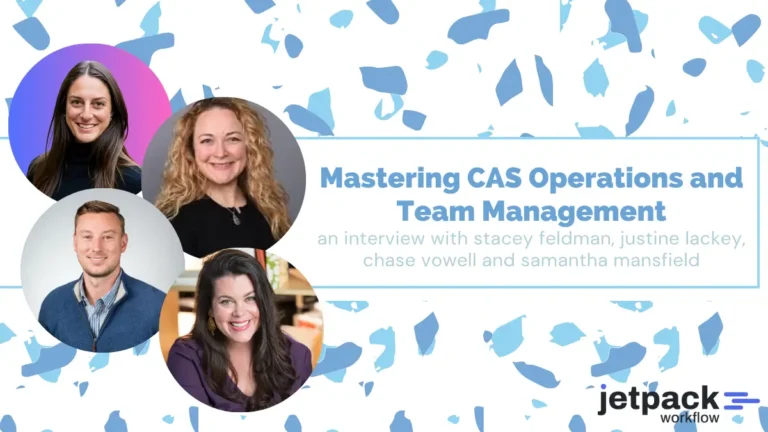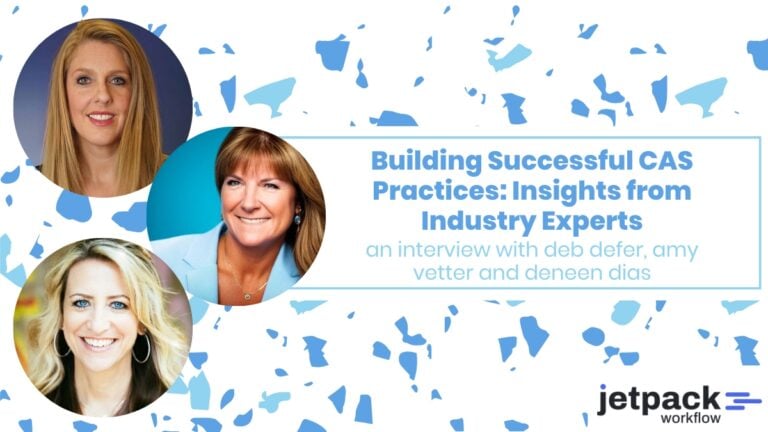CAS Panel: How to Scale Your CAS Department

Summary
In this engaging episode, the panelists Kane, Christine, and Matthew come together for an interactive discussion that prioritizes audience participation. The host emphasizes the value of live questions, encouraging listeners to ask their most pressing inquiries to gain actionable insights. Each panelist introduces themselves, setting the stage for a dynamic exchange of ideas. The episode promises to tackle challenging questions and delve deeper into topics that resonate with the audience, making it a must-listen for anyone looking to enhance their understanding of the subject matter. Join us for an informative and lively conversation that highlights the power of community engagement in learning.
The Importance of Establishing Clear Values and Communication Within a Rapidly Growing Team to Maintain Culture and Alignment
In a rapidly growing team, particularly within a Client Accounting Services (CAS) practice, establishing clear values and maintaining open lines of communication are essential for preserving the organization’s culture and ensuring alignment among team members. Insights shared by the panelists in the podcast episode underscore several key aspects of this importance.
1. Defining Core Values
Matthew May emphasized the significance of defining core values within the organization. He shared that his team engaged in a values exercise to articulate their principles, which ultimately helped align the team’s actions with the organization’s mission. By creating an acronym (M.I.T.C.H. – Measured, Independent, Transparent, Curious, Happy), the team could easily remember and communicate these values. This clarity enables team members to understand the expectations and behaviors that are valued within the organization, fostering a cohesive culture.
2. Values in Performance Reviews
Integrating these values into performance evaluations is another critical aspect. Matthew noted that these values serve as a framework for assessing employee performance and behavior. For instance, asking employees if they are “happy” in their roles can reframe difficult conversations and help identify areas for improvement. This approach not only reinforces the values but also encourages a supportive environment where employees feel valued and understood.
3. Transparency and Communication
Kane Polakoff highlighted the importance of transparency in maintaining alignment as the team grows. By sharing financial metrics and defining success for every individual, he ensures that all team members understand their contributions to the organization’s goals. This transparency fosters a sense of belonging and accountability, as everyone knows how their work impacts the overall success of the firm.
4. Regular Check-Ins and Engagement
Both Kane and Christine Triantos discussed the necessity of regular communication and engagement with team members. Kane mentioned that he personally interviews every new team member, which helps establish a connection and communicate the organization’s values directly. Christine added that including the entire engagement team in client meetings not only keeps everyone informed but also upskills junior team members, enhancing their understanding of client interactions and expectations.
5. Adapting to Change
As organizations grow, dynamics can shift rapidly. Christine pointed out that it’s essential to level set new team members to ensure they are aligned with existing standards and practices. This involves training and onboarding processes that reinforce established values and workflows, helping to integrate new hires into the culture seamlessly.
6. Building Trust
Trust is a fundamental component of a healthy team culture. Christine emphasized that staff need to trust leadership, especially during times of change. By encouraging open communication and demonstrating that leadership is invested in their growth and well-being, organizations can cultivate a loyal and motivated workforce.
Conclusion
In summary, establishing clear values and maintaining effective communication are vital for sustaining culture and alignment in a rapidly growing team. By defining core values, integrating them into performance evaluations, fostering transparency, engaging in regular check-ins, and building trust, organizations can navigate the challenges of growth while ensuring that their team remains cohesive and aligned with the overall mission. These practices not only enhance employee satisfaction but also contribute to the long-term success of the organization.
Utilizing Variable Compensation Models to Scale Teams Effectively
In the podcast episode, Matthew May discusses the significant role that variable compensation models play in scaling teams within the Client Accounting Services (CAS) sector. This approach not only helps manage costs but also attracts a specific type of talent that prioritizes flexibility over traditional stability in their income.
Key Points on Variable Compensation Models
1. Flexibility in Compensation:
Variable compensation allows employees to have a base pay that is lower than traditional fixed salaries, with the potential to earn more based on performance or billable hours. For instance, Matthew mentions that employees can choose to work under a model where they earn a higher hourly rate for billable work while receiving a lower rate for administrative tasks. This flexibility appeals to individuals who may prefer to work fewer hours or have varying workloads.
2. Attracting the Right Talent:
By offering variable compensation, firms can attract talent that values flexibility. This is particularly appealing to professionals who may be balancing other commitments, such as family or personal projects, and prefer a work-life balance that allows them to dictate their hours. Matthew notes that over half of their employees are on variable compensation models, which has been crucial for their growth.
3. Alignment with Business Goals:
The variable compensation model aligns the interests of employees with the firm’s goals. When employees are compensated based on their contributions to billable hours or project success, they are more likely to be motivated to perform well. This alignment fosters a culture of accountability and encourages employees to take ownership of their work.
4. Scalability:
As firms grow, the need for a scalable workforce becomes critical. Traditional fixed salaries can be a burden when trying to expand quickly. By implementing a variable compensation model, firms can manage their payroll expenses more effectively while still incentivizing high performance. This model allows firms to scale up or down based on workload without the financial strain of maintaining a large fixed salary workforce.
5. Creating a Dynamic Work Environment:
The flexibility offered by variable compensation can lead to a more dynamic and responsive work environment. Employees who thrive in such settings are often more engaged and willing to adapt to changing business needs. This adaptability is essential in the fast-paced world of CAS, where client demands can fluctuate significantly.
Conclusion
In summary, utilizing variable compensation models is a strategic approach for firms looking to scale their teams effectively. By attracting talent that values flexibility, aligning employee incentives with business goals, and creating a dynamic work environment, firms can not only manage costs but also enhance employee satisfaction and performance. As highlighted in the podcast, this model has been a key factor in the success of Matthew’s firm, demonstrating its potential as a best practice in the CAS industry.
Standardizing Workflows and Processes for Scalability
In the context of scaling a Client Accounting Services (CAS) practice, standardizing workflows and processes is essential. This standardization not only ensures consistency in service delivery but also enhances efficiency, making it easier to manage a growing team and client base. Here are some key points discussed in the podcast episode regarding the importance of standardization and the need for regular revisits to these standards:
Importance of Standardization
- Consistency and Repeatability: Standardizing workflows allows teams to deliver consistent results across different clients and projects. Christine emphasized that teams often struggle when they do not standardize their processes, leading to inefficiencies and errors. By having a set of standardized templates and workflows, teams can ensure that they are not reinventing the wheel for every client engagement.
- Scalable and Sustainable Practices: Christine also pointed out that a scalable, sustainable, and repeatable approach is crucial for building a successful CAS practice. This means that as the team grows, the processes should be robust enough to handle increased workloads without compromising quality.
- Client Adaptation: Instead of adapting to every client’s unique systems and software, teams should encourage clients to adapt to the firm’s standardized processes. This not only streamlines operations but also sets clear expectations for clients regarding the services they will receive.
Regularly Revisiting Standards
- Adapting to Changing Technologies: The podcast highlighted the rapid pace of technological advancements in the accounting field. Christine suggested that firms should revisit their workflows and standards every nine to fifteen months to ensure they are leveraging the latest tools and technologies effectively. This proactive approach helps firms stay competitive and responsive to client needs.
- Testing New Software: When implementing new technologies, it is crucial to test them with a select group of clients and team members before a full rollout. This allows firms to identify potential issues and address them, ensuring a smoother transition and minimizing disruptions to service delivery.
- Level Setting Across Teams: As firms grow and onboard new team members, it is vital to level set on standards and expectations. Christine mentioned that having all team members, from staff to managers, involved in client meetings helps ensure everyone is on the same page and understands the firm’s standards. This collective knowledge fosters a cohesive team culture and enhances service delivery.
- Continuous Improvement: Standardization should not be a one-time effort. As Kane noted, firms should continuously refine their processes based on feedback and performance metrics. This iterative approach allows firms to adapt to changing client needs and market conditions, ensuring long-term success.
In conclusion, standardizing workflows and processes is a foundational element for scalability in CAS practices. By regularly revisiting and refining these standards, firms can adapt to new technologies and evolving client expectations, ultimately leading to improved service delivery and client satisfaction.
Timestamps
[00:02:02] Evolution of CAS in industry.
[00:06:13] Scaling teams and break points.
[00:10:53] Capacity planning in growth.
[00:12:25] Strategies for scaling teams.
[00:16:22] Staffing model for industry verticals.
[00:19:05] Revenue recognition teams in staffing.
[00:22:27] Value of quality assurance.
[00:27:45] Scaling team culture challenges.
[00:29:18] Company values in performance reviews.
[00:34:25] Team values during rapid growth.
[00:37:29] Employee and client retention importance.
[00:40:10] Building awareness for CAS careers.
[00:44:35] Employee retention importance.
[00:47:26] Hiring ahead in pipeline management.





